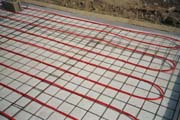Heating Trends Radiant Insulation: Tarp Vs. Board
Insulating under a poured slab for radiant heating applications is nothing new, even in an industry that's only been around the last third of a century.
But emerging products and materials have changed the way Wet Heads are designing and installing radiant slab systems. We'll take a brief look at two types of slab insulation available - foam board and tarp or pad - and the pros and cons surrounding each.
Foam Favorite
“You can't go wrong using insulation in a slab system,” says radiant contractor extraordinaire Bob “Hot Rod” Rohr, who's not above doing his own informal testing of products to compare results useful for a jobsite. “Is insulation always needed? No, not always.” It's the environment conditions and regions that determine what type of insulation to use, says Rohr.
For example, do you need to completely insulate a basement slab built on the sandy soils of Memphis? Maybe not. But jobsites in Anchorage or the granite grounds of Utah will probably require some form of insulation.

The use of extruded polystyrene foam (XPS) board insulation has been typical up until now. Products such as Dow Chemical Co.'s “blueboard” maintains its insulating power over time, resists moisture absorption and offers compressive strength, a key feature for slab installations.
Its high thermal efficiency (R-value, or resistance to heat flow) is particularly helpful around the edges of a radiant design.
“You should at least insulate the perimeter - at least 1 1/2 to 2 inches - because that's where it's exposed and a majority of heat is lost,” offers Rohr, who uses blueboard in many different thicknesses at several of his radiant jobs. Another benefit of foam is its ability to allow slab expansion and decrease potential external restraint cracking.
Tarp Tug-O-War
New to the slab insulation market is the use of tarp-type and pad insulators. These types of products are available in large rolls of layered materials (including foil or aluminum, bubble and plastic layers, etc.). Its thermal efficiency relies on the trapped air within its layers. While slightly more expensive than foam board, tarp insulation brings different benefits to the table.
“Tarp is good over uneven ground, and it provides an insect barrier with its aluminum layer,” says Rohr, who has used Insul-Tarp to his satisfaction in many applications. Tarps are virtually impervious to liquid, and it is easy to install (no seaming, just overlap the edges).
And while rigid board isn't appetizing to vermin and insects, it does provide a burrowing ground for certain pests. The aluminum integrated within tarp insulators is like nails on a chalkboard to insects and repels them easily.
The Concrete Pad offered by Reflectix Inc. is “another way of doing things,” says Monty Millspaugh, vice president of technical services for the company. The pad's seven layers form a radiant barrier for under-slab insulation. It has a puncture resistance of 60 lbs./inch and resists mold, mildew and insects.
“Contrary to what's believed, heat doesn't rise; it travels to the coldest surface,” says Millspaugh. In slab instances, the coldest place is the ground underneath. “In general, when you're using concrete as a heat source, it would not make sense to let heat escape through the ground.”
A slight controversy has risen where tarps are concerned, however. Because of the multiple tests available by the American Society for Testing and Materials, the thermal performance of a single insulating product can vary within different tests. This has led a few manufacturers to boast thermal resistance values that can be misleading.
“Fudging” or overrating the performance of a product has so far been considered legal, since manufacturers can provide calibrated testing data to back up their claims.
“Some say that their 1/4-inch tarp performs like an R-5 foam, or a 1/4-inch is just as good as an inch,” says Rohr. “But it either is or it isn't. They've started to back off some of these claims and changed the wording around.”
Enforcement of insulation standard tests lies with the U.S. Federal Trade Commission. To date, no federal action has been taken by the FTC against an insulation manufacturer for providing misleading R-values.
Bottom Line
In an industry where an industry consensus is the closest it has to a radiant code, there is no clear-cut way to approach the use of insulation. The Radiant Panel Association recently released its “Radiant Flooring Guide,” where it recommends a minimum R-value of 5 for slab installations, but components and applications should always be taken into account, says RPA Technical Director John Fantauzzi.
No matter how thick the insulation is, it never completely stops heat loss; its barrier just slows down the process.
So how much insulation is enough? It all comes down to how much you want to spend.
“The ultimate decision whether to insulate or how is the homeowner's,” concludes Rohr. “What contractors can do is research and accurately communicate their experience to the owner, and let them make the decision based on that.”
Looking for a reprint of this article?
From high-res PDFs to custom plaques, order your copy today!







